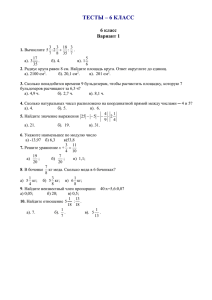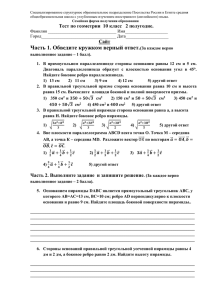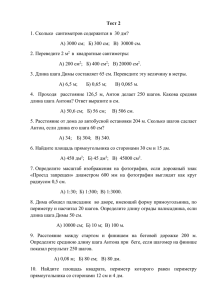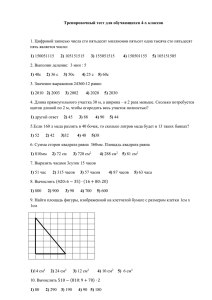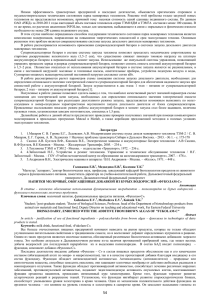Перспективные Li-O2 системы накопления энергии для
advertisement
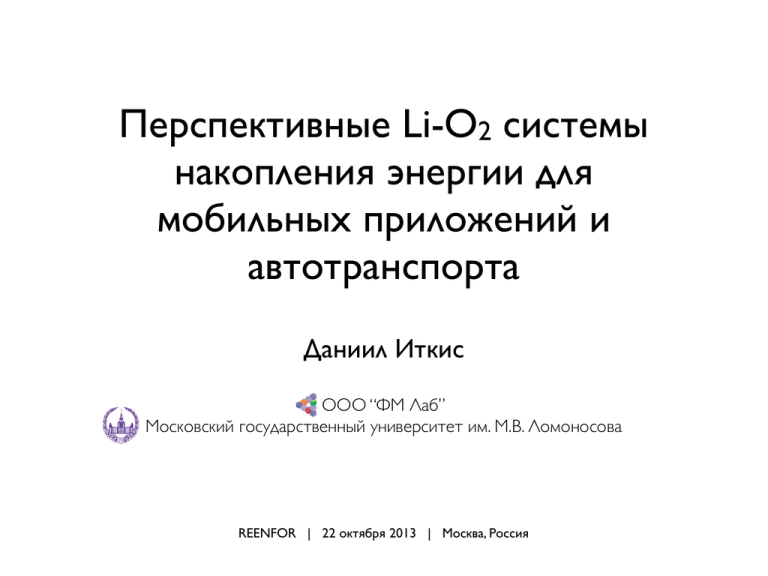
Перспективные Li-O2 системы накопления энергии для мобильных приложений и автотранспорта Даниил Иткис ООО “ФМ Лаб” Московский государственный университет им. М.В. Ломоносова REENFOR | 22 октября 2013 | Москва, Россия Области применения аккумуляторов Sung Kyun CHANG, LG Chem, Korea, “Introduction to Battery R&D”, OECD workshop on "Nanotechnology for sustainable energy options", 2010 2 Современный ДВС Мотор-колесо Мощность 326 л.с. Мощность 80 х 4 = 320 л.с. КПД двигателя ~ 40 % КПД двигателей > 90 % Общая эффективность: Общая эффктивность: < 20 % 90 % 3 onal Motor Museum Beaulieu.) 4 Electric Vehicle Technology Explained 1.2 Camille Jenatzy’s ‘La Jamais Contente’. This electric car held the world land speed in 1899, and was the first vehicle to exceed both 60 mph and 100 kph 1899 год Vehicle with a range of about 50 km as internal combustion engine vehicles were at the time unreliable, smelly and d to be manually cranked to start. The other main contender, the steam engine e, needed lighting and the thermal efficiency of the engines was relatively low. the 1920s several hundred thousand electric vehicles had been produced for use as Tankdespite containing 4 kgof the early vans, taxis, delivery vehicles and buses. However, the promise (4.5 litres) of fuel with a calorific value of 36 000 Wh Engine and gearbox with an efficiency of 20% Shaft energy obtained is 7200 Wh Electric motor and drive system with overall efficiency of 90% Lead acid battery with a mass of 270 kg, volume 135 litres, and energy 8100 Wh Shaft energy obtained is 7200 Wh Vehicle with a range of about 500 km Electric Vehicle Technology Explained by J.Larminie and J.Lowry, John Willey&Sons, 2010 Engine and gearbox with an 4 5 Общая масса 1500 кг Масса батареи 300 кг Энергозапас 24 кВтч Пробег без подзарядки <150 км Для обеспечения запаса хода 500 км потребуется 70 - 80 кВт ч Вес литий-ионной батареии увеличился бы до 900 кг ! 6 графит LiCoO2 7 запасание большего количества Li+: переход от LiCoO2 или LiFePO4 (< 0.2 Ач/г) к V2O5 (0.3 - 0.4 Ач/г) запасание большего количества Li+: переход от C6 (0.2 Ач/г) к Si (4 Ач/г) увеличение напряжения: переход от LiCoO2 или LiFePO4 (3.6 - 3.8В) к LiCoPO4 и аналогам (5 В) смена принципа: использование металлического лития (3.8 Ач/г) смена электролита смена типа ионов: Li+1 масса 7 а.е.м. Mg2+ масса 24 а.е.м Al3+ масса 27 а.е.м. смена электролита смена принципа: использование серы как окислителя (до 600 Втч/кг) смена обоих электродов и электролита смена обоих электродов, электролитов и конструкции смена принципа: использование кислорода как оксилителя (выше 1000 Ктч/кг) 8 удельная энергия, Вт⋅ч / кг >550 км 900 800 700 >400 км 600 500 400 >200 км 300 200 100 50 км 70 км 80 км <140 км 0 Pb-PbO2 Ni-Cd цена, $/кВт⋅ч 200 600 Ni-MH 900 доступны Li-ион Li-металл полимер 600 Li-S Li-O2 <150 <150 <150 НИОКР НИР * данные из работы P.G.Bruce et al. Li-O2 and Li-S batteries with high energy storage // Nature Materials 11 19-29 (2012) 9 Journal of The Electrochemical Society, 159 R2 may form reaction of LiCl:9 Driving range (miles) 500 1,000 Wh/kg, future Li/air 400 300 2 Li 400 Wh/kg, future Li-ion 200 200 Wh/kg, 200 Wh/kg, current state ofcurrent the art state Li-ion of the art Li-ion 100 0 0 100 200 300 400 500 Battery pack weight (kg) J. Christensen et. al. // J Electrochem Soc 159 (2012) Figure 1. Driving range and battery weight for different cell-level specific Anoth of Li2 SO the advan the form exclude and O2 i have a lo a lower s been dis the same for a giv high vap evaporati a reactio fall into 10 our atten Li-O2 аккумулятор Li → Li+ + e- O2 + 2Li+ + 2e-→ Li2O2 удельная энергия на массу Li ≈ 11 кВтч/кг на массу активных веществ (Li, O) ≈ 3.5 кВтч/кг на массу устройства до 1 кВтч/кг 11 Ключевые проблемы анод пористый катод продукт разряда Li → Li+ + eЗагрязнения из внешней среды: Li + H2O → LiOH + H2 Li + O2 → Li2O Изменение объема Дендритообразование O2 + nLi+ + ne-→ LiOx Загрязнения из внешней среды: Li2O2 + H2O → LiOH + O2 Li2O2 + CO2 (влаж.) → Li2CO3 + O2 Обратимость Транспорт Li+, e- и O2 в электроде 12 ОТРИЦАТЕЛЬНЫЙ ЭЛЕКТРОД подавление роста дендритов 13 LiC6 vs. Li Графит - не более 372 мАч/г Равномерный рост SEI Литий - около 3800 мАч/г Дендритообразование 14 ECS Transactions, 25 (35) 23-34 (2010) Дендритообразование при э/х осаждении лития 4) Random exchange currents generated at every cycle, for e were renormalized to correspond to constant total current, an distributions: Uniform, Normal and Log-Normal. From these simulations, we have found that: 1) The type of current distribution plays only a minor role at low Depths of Discharge Journal of The Electrochemical Society, 159 (2) R1-R30 (2012) (DoD), and plays no role at DoDs appro 2) The uniformity of the current distribution (standard devi distribution) plays a major role in morphology development. Li2O 2 cell before dis charge Li/LiMO celltobefore dislithium charge 3) At2 low moderate DoD, the lithium surface rough of the square root of the number of cycles. 4) Morphology limited Cycle life (N) was a function of the inve or the number of mAh/area (Q) or thickness (Th) of stripped5) At higher lithium DoD, roughness development and cycle CC CC CC CC presence or absence of a current collector. Cycle life was Li metal LP S L P os itive electrode G DL Liwithout metal a LP S L collector. P os itive electrode current (w/ 20% (70 vol. % gas ) (w/ 20% (65 vol % MO 2) exces s ) exces 0.2 s ) CC 20% LP S L P os itive electrode G DL (65 vol. % Li2O 2) exces s Li metal Li /LiMO 2 cell after dis charge CC Surface Roughness Li2O 2 cell after dis charge 0.1 CC CC 20% LP S L P os itive electrode exces s (65 vol. % LiMO 2) 0Li metal 0 0.2 0.4 0.6 0.8 1 Li DoD chematic showing the significant amount of volume change that occurs when Li metal cells are discharged. The cell on the left has a high-capacit 15 material (Li O ) while the cell on the right has a lower-capacity intercalation active material (LiMO ). LPSL = Lithium Protection Separator Laye Подавление роста дендритов 5 мАч/см2 0.5 мА/см2 ≈ 6.5 Н/см2 Полиимидный сепаратор Celgard 2075 1000 5 10 15 20 25 2 500 0 перенапряжение ≈ 1 мВ E, мВ –2 0 –500 –1000 выход из строя перенапряжение ≈ 100 мВ 0 5 10 15 20 25 Время, дни 16 ЛИТИЙ-ПРОВОДЯЩАЯ МЕМБРАНА высокая ионная проводимость газоплотность 17 Необходимость в твердом электролите Li+ Li+ H 2O H 2O N2 Li+ O2 CO2 + Li CO2 - Li+ O2 + Li2O2 Литиевый электрод после 2-х недельной работы ячейки 18 + Li -проводящие стеклокерамический мембраны плавление/закалка кристаллизация 100 μm 100 μm 100 μm 100 μm 100 μm керамика спекание полировка порошок мембрана Li1.5Al0.5Ge1.5(PO4)3 19 + Li -проводящие стеклокерамический мембраны 0.6 150 0.4 100 0.3 0.2 50 0.1 ~ 10-7 Ом-1⋅см-1 0 σ, ×10-3 Ом-1⋅см-1 Размер частиц, нм 0.5 проводимость до 0.5 мСм/см газопроницаемость менее 0.1 Баррер 0.0 1 2 3 4 5 6 Время кристаллизации, ч 20 ПОЛОЖИТЕЛЬНЫЙ ЭЛЕКТРОД очень высокая емкость необратимость/низкая циклируемость 21 Тестирование прототипов Li-O2 ячеек Емкость до 30 мАч Номинальное напряжение 2.7 – 2.8 В Ток разряда до 1.5 мА Удельная энергоемкость до 2.5 кВтч/кг (на массу лития, кислорода и углерода) 22 Сохранение емкости, % Тестирование прототипов Li-O2 ячеек 50 мкА/см2 2.5 500 мкА/см2 2.0 1.5 1 2 3 4 5 6 Заряд, мАч/см2 7 500 мкА/см2 60 40 20 0 8 50 мкА/см2 1 2 3 4 Номер цикла 5 0 0 200 Porocarb HS Ketjenblack EC600JD Ensaco 350G Thermophit GFG5 5 Vulcan XC72 10 Super C65 15 Super C45 20 Timrex KS4 Удельная энергия, кВт⋅ч/кг 0 80 Ketjenblack EC300J Напряжение, В 3.0 100 400 600 800 1000 Удельная поверхность, м2/г 1200 1400 23 Механизмы деградации электрохимическая стадия Li+ Ȯ2- + e- + Li+ → Li2O2 + Li O2 e электрохимическая стадия диспропорционирование 2 Li+ Ȯ2- → Li2O2 + O2 O2 + Li+ + e- → Li+ Ȯ2O2 e + Li + Li O2 e + Li O2 O2 O2 + Li + Li + Li 2O2 + Li + Li 2O2 + Li химическая реакция с углеродом O2 + Li Li2CO3 e O органический карбонат O + Li O O2 24 эпоксидные группы LiRCO3 D.M. Itkis, D.A. Semenenko, E.Yu.Kataev, A.I. Belova // Nano Letters 13 (2013) Механизмы деградации Li2O2 platelets O2 Li+ eelectrode Ȯ2 Li2O2 crystal cluster Li2O2 + O2 - crystallization T.K. Zakharchenko, A.Ya.Kozmenkova, D.M. Itkis, E.A. Goodilin // Beilstein Journal of Nanotechnology (2013) 25 assembly Dr. Pavel Dudin Dr. Alexey Barinov spectromicroscopy Prof. Eugene Goodilin Dr. Michael Havecker Dr.Vera Neudachina Dr. Axel Knop-Gerike BEESY II ISISS Moscow State University Dr. Lada Yashina Dr. Detre Teschner Prof.Yang Shao-Horn Dr. Lev Trusov Materials Science dept. Dmitry Semenenko Egor Pleshakov Anna Kozmenkova Alina Belova Tatyana Zakharchenko Victor Vizgalov Elmar Kataev Alexander Gavrikov Dr.Victor Krivchenko Chemistry dept. Sofia Ionova MIPT Artem Sergeev 26
